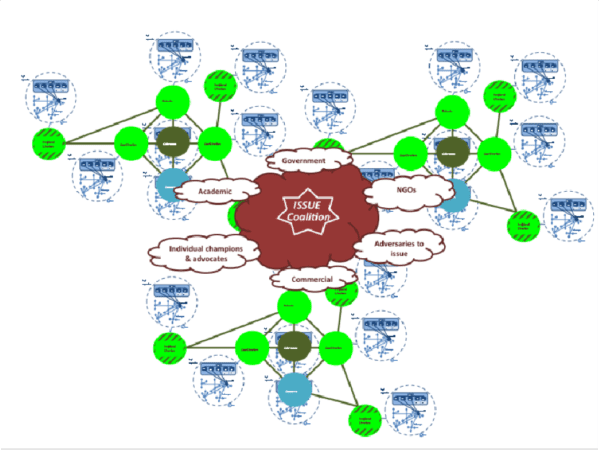Last weekend I pondered a question my colleagues (Socio-Technical Systems Roundtable) and I are considering as we document our community’s action research discovery process.
How do we inspire and coordinate the collaborative design-build of an Issue-Based Ecosystem (IBES)?
In essence, the Socio-Technical Systems (STS) Roundtable, as an organizing body, is reinventing itself to better serve its world-wide membership and its clients. The reinvention consists of moving from a closed body of international STS practitioners who met f2f annually to an open global network of peers sharing a common purpose (an IBES).

Without the membership’s collective and considerable research into emerging new forms of organizing, adaptive enterprises and Socio-Technical System’s organizational design, we would not have been able to formulate the question that inspired this blog.
This collaborative research investment is becoming the norm for most learning and transformation in today’s world where the New Normal is volatile, uncertain, complex and ambiguous. The ‘wicked’ problems of today — or what we all experience as emerging new phenomena in today’s social, technological, ecological and economic environments — challenge each of us to explore and invent new solutions. Why? . . . because the old paradigms, ways of being and doing, no longer make sense or satisfy.
In case you are wondering how this all applies to you, both our personal and work lives are equally and critically impacted. On a personal level, most of us are asking a similar but not simpler question — What is my passion? That is, what do I love to be (personally) and do (professionally) in the world that creates a sense of meaningfulness, community and contribution? Answering this personal question necessitates answering or satisfying our professional contribution because most of us translate ‘doing’ into working.
To add to this already heavy agenda of personal and professional exploring and inventing in collaboration with others (no one has the necessary resources to do it alone), we must simultaneously maximize our effectiveness and efficiency with the tried and true.
This ‘both/and’ (or should I say ‘many/and’) agenda of simultaneous innovation and optimization — surviving and thriving — echoes the foundational design principles of STS theory and practice. Most significantly, STS design jointly optimizes all systems (social, technical, ecological and economical) by ensuring that the people who do the work design the enterprise.
This was much easier to see in the workplace of the 20th century. In the 21st century workplace, the people who do the work may belong to a single firm (a VIDO – Vertically-Integrated Decentralized Organization), a network of supply chains (a VRN – a Value Realization Network) or a societal network of individuals, supply chains and enterprises (an IBES – Issue-based Ecosystem). In fact, our research indicates that these three levels of complexity must also be coordinated simultaneously because every individual or firm is interdependently nested within a larger system.
With such complexity being our daily human experience, it makes sense that no one person or firm has all the resources necessary to ‘get its head around’ the challenges or the solutions. Whether we like it or not, our inability to solve these challenges alone is requiring us to join forces and unite our collective SPICE (spiritual, physical, intellectual, communal and emotional) capabilities — whole system analysis, action and adaptation.
Whenever humans are brought together from different cultures and continents, we witness the creative genius of the human spirit in their diversity of values and experiences. Harnessing this creative genius on a global scale to serve a mutually shared interest is the mission of an IBES. In the case of the STS Roundtable IBES, the mutually shared interest would entail “an open learning community advancing the ideals, theory and practices that create humane, prosperous and sustainable work and communities — better places to work and places that work better.” (STS-RT working vision)
Having just read about some of the complexity in designing an IBES, you can appreciate why our original question morphed into –
How do we inspire and coordinate an international community of shared interest to Connect, Converse, Collaborate and Co-create© in designing itself?
Answering this question is the topic of a forthcoming book based on the STS Roundtable Discovery Process and its subsequent organization redesign. However, the primary reason this learning community is tackling such a monumental design task is to align its passion and vision (better places to work and places that work better) with one of the world’s greatest needs (community building). This alignment is crucial to both inspire and attract others as well as to coordinate the creative genius necessary to solve the world’s ‘wicked’ problems — starvation, oppression, illiteracy, violence, climate change, environmental degradation, economic inequities. If it takes a community to raise a child, it most certainly takes a community to seed world consciousness with dignity, meaningfulness, dialogue and collective creativity.
What communities are you a member of? In those communities, what seeds of inspiration and coordination support community development and enrichment?





